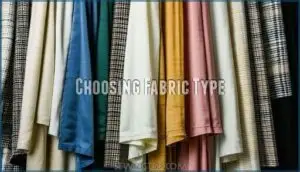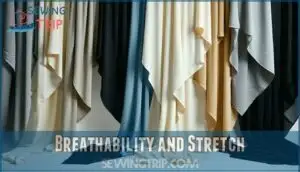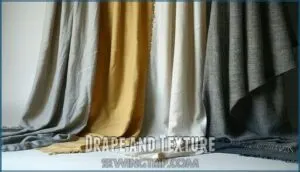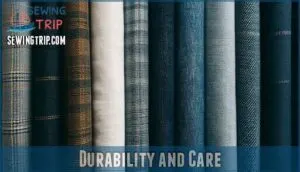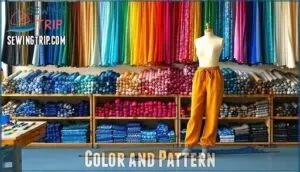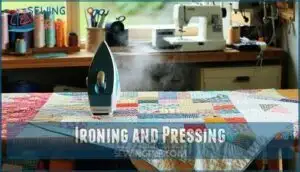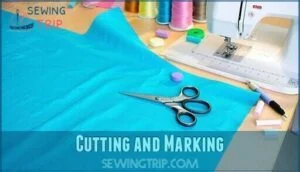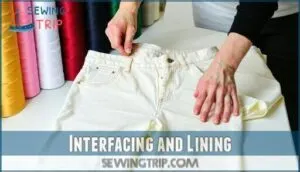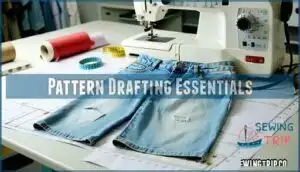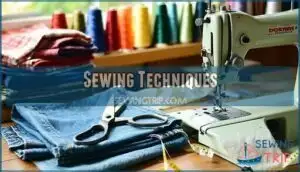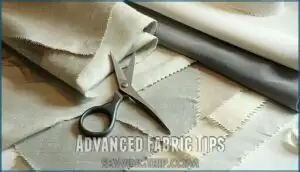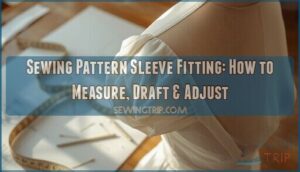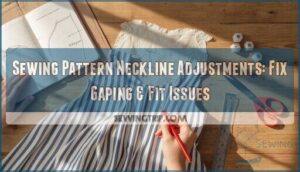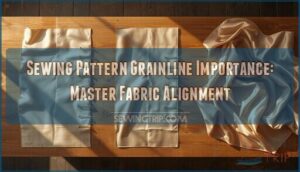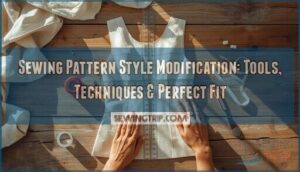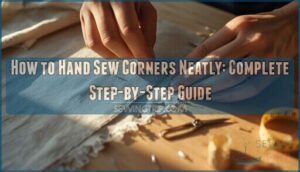This site is supported by our readers. We may earn a commission, at no cost to you, if you purchase through links.

Go for cotton or blends if you want something breathable and easy to sew—perfect for beginners.
Wool or polyester makes sturdier options, great for custom looks or winter wear.
Silk and viscose bring a touch of luxury with their smooth drape, but they can be tricky to handle.
For seasonal comfort, keep weight in mind—lighter fabrics for summer, heavier for winter.
Pay attention to stretch if you’re making fitted styles, and choose a fabric that holds its shape.
Pre-washing is key—don’t skip it!
Ready for more tips?
Table Of Contents
Key Takeaways
- Always pre-wash and dry your fabric to prevent shrinkage and ensure accurate cutting for your pants.
- Choose fabric weight based on the season, like lightweight for summer or heavier for winter.
- Pick fabrics with the right stretch, breathability, and durability to match your intended pant style and comfort.
- Use the right tools and techniques, like sharp scissors and proper grainline alignment, for clean cuts and professional results.
Choosing Fabric Type
You’ll need to select the right fabric type for your pants project to guarantee comfort and proper fit.
Your choice between cotton, wool, silk, or synthetic blends will determine how your pants look, feel, and function throughout their lifetime.
Selecting between cotton, wool, silk, or blends shapes your pants’ style, comfort, and durability for all-day wear.
Cotton and Blends
Cotton blends offer you the perfect combination of comfort and durability for pants sewing fabric.
They maintain shape better than pure cotton while providing excellent breathability. The weave types determine how your pants will look and feel.
- Soft cotton twill embraces your legs without feeling restrictive
- Sturdy cotton gabardine stands up to daily wear like a loyal friend
- Lightweight cotton poplin keeps you cool when temperatures soar
- Cotton-stretch blends move with you through every bend and twist
Wool and Polyester
During winter months, wool-polyester blends offer the perfect combination for pants.
You’ll appreciate wool’s natural warmth and structure alongside polyester’s durability and wrinkle resistance.
Typically containing 60-80% wool and 20-40% polyester, these fabrics provide excellent drape for dressy pants while requiring minimal maintenance.
For sewing, use universal needles (80/12 or 90/14) and apply very low heat when pressing.
These blends work wonderfully for year-round formal wear.
Silk and Viscose
While wool and polyester provide structure, silk and viscose offer elegant drape characteristics for pants with a luxurious feel.
Silk’s natural luster and strength make it appealing, though it’s known to be tricky to sew. Viscose, with its beautiful weave structures, creates flowing pants but requires careful handling during cutting.
Viscose is a popular choice because of its soft and breathable nature. For lightweight viscose, use 1.5-2mm stitches; heavier fabrics need 2.5mm stitches for proper fabric selection and wrinkle resistance.
Fabric Weight and Season
Throughout the year, your pants’ fabric weight should match the season for ideal comfort.
Lightweight fabrics (2-7 ounces) work best for summer pants, offering breathability in hot weather.
Medium weights (8-12 ounces) provide ideal climate comfort for fall trousers and stretch jeans.
Heavier fabrics (12+ ounces) deliver essential fabric warmth for winter.
The weight impact affects not just seasonal comfort but also how your pants drape and wear daily, which is crucial for ideal comfort.
Fabric Selection Criteria
You’ll need to take into account four key factors when selecting fabric for your pants project: breathability, stretch, drape, and care requirements.
Your fabric choice will determine both the comfort of your finished pants and how well they’ll hold up through regular wear and washing, considering factors like care requirements.
Breathability and Stretch
Now that you’ve explored fabric types, let’s consider how they feel against your skin and move with your body.
When sewing pants, breathability and stretch determine comfort and wearability.
- Cotton with 1-2% spandex offers natural breathability with subtle stretch
- Weave structure affects air circulation (twill is less breathable than plain weave)
- Activewear fabrics blend performance with comfort for summer pants
- Fiber content directly impacts your comfort level during all-day wear
Drape and Texture
How does your fabric move and feel against your skin?
Drape and texture substantially impact how your pants will look and feel when worn.
Fabric hand determines whether pants flow elegantly or stand structured.
Choose fabrics with visual texture and tactile appeal that suits your project – linen’s natural slubs add character while wool gabardine offers smooth sophistication.
Remember, good fabric drape pants will complement your body’s movement rather than restrict it, with a focus on natural slubs and tactile appeal.
Durability and Care
Choosing a durable pants fabric guarantees your sewing pants project lasts.
Wash durability and stain resistance matter—cotton, twill, or blends hold up well.
Prevent pilling by selecting sturdy fabric types for pants, like wool or poly-viscose.
Check colorfastness testing and follow fabric care instructions.
Long-term care includes low-heat drying and proper storage to extend wearability.
Twill weaves enhance fabric strength and longevity.
Color and Pattern
Bright, bold, or neutral – color fabric pants transform your look.
Patterns bring personality, but consider their impact.
Follow these tips:
- Use color psychology to match moods (e.g., calming blues or bold reds).
- Pick pattern scale to suit body proportions.
- Check print direction for design flow.
- Mix patterns carefully or stick to seasonal palettes for harmony.
Preparing Fabric
Before cutting your fabric, wash and dry it to prevent unexpected shrinkage later. Press out the wrinkles with an iron to guarantee smooth, accurate cutting and marking.
Washing and Drying
To avoid shrinkage surprises later, always prewash fabric before sewing pants.
Check care instructions—use gentle cycles for delicate fabric types. Test for colorfastness to prevent dye transfer.
Drying methods matter: air-dry lightweight fabrics; tumble dry sturdier ones like denim.
Pre-wash benefits include softer texture and accurate fabric requirements. Using a suitable washing detergent can further enhance fabric preparation.
Washing guarantees your pants won’t disappoint after first wear, ensuring a softer texture and providing accurate fabric requirements.
Ironing and Pressing
Proper ironing and pressing keep your project smooth and professional. Always check the iron temperature to fit your fabric type.
Use pressing tools for sharp seams and edges. Preventing shine is easy: cover delicate materials with a pressing cloth. Proper fabric preparation can also involve pre-washing the material before beginning.
Follow these sewing tips:
- Use steam for tricky fabrics.
- Press seams flat before opening.
- Avoid dragging the iron.
- Press, don’t iron, delicate pieces.
- Test techniques on scraps.
Cutting and Marking
After ironing, focus on fabric cutting and marking.
Align the fabric grain with the grainline on your pattern pieces.
Use pattern weights to keep everything in place.
Mark seam allowances with chalk or pens.
Plan your cutting layout to maximize fabric use.
Sharp scissors guarantee clean edges.
Selecting the right tools can greatly improve accuracy, so consider investing in specialized cutting implements.
| Task | Tool | Purpose |
|---|---|---|
| Marking grainline | Tailor’s chalk | Align patterns |
| Holding patterns | Pattern weights | Prevent shifting |
| Cutting fabric | Fabric scissors | Clean cuts |
| Marking seam lines | Pens/chalk | Accurate sewing |
| Positioning patterns | Ruler/yardstick | Precise layout |
Interfacing and Lining
Once you’ve cut your fabric, it’s time to think about adding structure and smoothness.
Interfacing types, like fusible or sew-in, stabilize waistbands and hems. Lining fabrics, such as cotton or satin, prevent itchiness and add polish.
Don’t skip pocket lining for durability—perfect for everyday wear. Fusible interfacing options can provide excellent adhesion.
Reinforcement materials keep your pants feeling sturdy, sleek, and professional.
Pattern Drafting Essentials
Getting your pattern drafting right is the key to well-fitting pants, so start with accurate measurements and double-check them.
Pay attention to grainlines, seam allowances, and notches to guarantee each piece aligns correctly during assembly, which is crucial for ensuring that the pants fit as intended, making accurate measurements essential.
Measuring and Sizing
Accurate body measurements are key to sewing pants that fit perfectly.
Use a measuring tape to record waist measurement, hip placement, and inseam length.
Refer to size charts for sewing pattern sizing and adjust as needed, using either metric or imperial measurements—just stay consistent.
Don’t rush; mistakes in leg length or pattern adjustment can derail progress.
Grainline and Alignment
Understanding the grainline is like following a map for your pattern pieces—it guarantees everything aligns perfectly.
Always check the fabric grain direction before laying your pattern. For stripes, make certain stripe alignment across seams for a polished look.
Cutting accuracy matters, especially on bias fabrics, which stretch easily. A precise pattern layout creates pants that fit and drape beautifully, ensuring a perfect grainline and proper stripe alignment.
Seam Allowance and Notches
A good seam allowance width, typically 1/2 inch, gives room for adjustments.
Notch placement on sewing patterns guarantees pattern pieces align perfectly—don’t skip this step.
For curves, clipping prevents puckering, while grading seams reduces bulk.
Follow your sewing pattern instructions closely, especially in reinforcing seams. These techniques sharpen results, even for sewing patterns for beginners.
Hem and Waistband
When drafting hems and waistbands, consider fabric types pants require.
Choose clean hem finishes like blind hems or cuffed hems to match the style.
Explore waistband styles: elastic waistbands work well for casual designs, using elastic types suited to comfort.
Always factor hemming into measurements—your fabric guide guarantees results stay polished, practical, and in line with your creative flair.
Sewing Techniques
Mastering sewing techniques is key to creating well-fitted and durable pants. You’ll work on essentials like sewing inseams, attaching waistbands, and reinforcing seams for a professional finish.
Inseam and Rise Seams
When sewing inseam and rise seams, make certain your grain alignment matches the pattern for smooth fitting.
Use body measurements (metric or imperial) for accurate placement. The crotch curve is key—pin carefully to avoid fitting issues.
Stitch types like straight or zigzag work well, but add seam reinforcement at the crotch seam. Stick to proper seam allowance for durability.
Waistband and Elastic
After stitching the rise seams, it’s time to nail the waistband.
Measure elastic length snugly but comfortably around your waist.
Choose elastic types suited for waistband styles—flat or braided work well.
Fold casing options evenly, ensuring secure stitching to hold the elastic.
Thread the elastic, overlap ends, and sew securely for sturdy, adaptable pants from this sewing pants guide.
Pockets and Embellishments
When adding pockets and embellishments, focus on both style and function.
Use these ideas to elevate your pants:
- Add faux welt pockets for a polished look.
- Use lining fabric for pocket bags to reduce bulk.
- Try back pockets with decorative stitching for flair.
- Include button details or trim for added charm.
- Experiment with welt pockets for a professional finish.
To guarantee longevity, consider pocket durability for a professional finish.
Zigzag Stitch and Reinforcement
Zigzag stitching is your go-to for Seam Reinforcement and Edge Finishing, especially in areas like the crotch, which endures high stress.
Adjust Stitch Density on your sewing machine to increase Fabric Stability.
For added durability, consider bartacks or topstitching. Incorporating these sewing techniques into your sewing pattern alterations guarantees your pants withstand wear and tear without compromising comfort or style.
Advanced Fabric Tips
You can take your sewing projects to the next level by mastering advanced fabric techniques like working with linings, interfacing, and stay tape.
These details both improve the durability and fit of your pants and give them a polished, professional finish.
Working With Linings
Lining fabrics really level up your pants.
They’re great for adding warmth, preventing show-through, and improving drape.
Lightweight options like silk or polyester work well, depending on your fabric weight pants.
They also enhance comfort, especially if your sewing pattern fabrics are scratchy.
Just match your lining fabric to the project—sewing pattern textiles should move harmoniously with your outer material to achieve a perfect balance.
Interfacing and Stay Tape
Interfacing and stay tape are lifesavers for neat finishes and structure.
Here’s how:
- Pick interfacing types: fusible for ease, sew-in for delicate fabrics.
- Use stay tape to stabilize stretch seams.
- Reinforce areas like waistbands, pockets, and cuffs.
- Match interfacing weight to fabric.
Test fabric preparation to avoid wrinkles or bubbles before sewing details. Always remember to keep in mind woven interfacing characteristics for enhanced garment structure, using the right interfacing for a professional finish.
Buttonholes and Zippers
Mastering buttonholes and zippers makes pants both functional and stylish.
Use nylon zippers for lightweight fabrics and metal teeth for durability. For fly fronts, press seams neatly before zipper installation.
Buttonhole types matter; choose eyelets for strength or bar tacks for finesse. Plan button placement with a button placket layout, and explore zipper alternatives like hooks or snaps.
Test first!
Couture and Efficient Workflow
When sewing pants with couture precision and speed, plan smartly.
Stripe matching? Use single-layer cutting for accuracy. For perfect seams, focus on strong seam construction and sharp pressing.
To save time and material, think about fitting adjustments early.
- Use tools: Try pattern draping for perfect fit.
- Press thoughtfully: A hot iron changes everything.
- Optimize layout: Aim for fabric efficiency.
Frequently Asked Questions (FAQs)
How much fabric do I need for a pair of pants?
In the context of sewing pants, stick to the rule of thumb: 2 yards of fabric for smaller sizes, 5 for larger.
Always check your pattern for specifics, considering fabric width and style, to ensure you have the right amount of fabric.
What is the correct order to sew pants?
Start by sewing the side seams, then the inseams.
Join the crotch seam next, ensuring alignment.
Attach the waistband, inserting elastic if needed.
Finish by hemming the legs for a polished look.
How many yards should I get for pants?
You’ll typically need about 2 yards of fabric for sewing pants, though larger sizes may require closer to 5 yards.
Always check your pattern’s fabric recommendations and pre-wash to prevent shrinkage surprises later.
How do you measure yourself for sewing pants?
Grab a tape measure and check key spots: your waist (natural curve), hips (widest part), and desired pant length (waist to hem).
Stand straight, and don’t pull the tape too tight.
How to choose eco-friendly fabrics for pants?
Pick organic cotton, hemp, or recycled polyester for eco-friendly pants.
Avoid synthetic blends.
Check fabric certifications like GOTS or OEKO-TEX.
Pre-wash to guarantee quality, and prioritize durability to maximize wear and reduce waste.
What are the best fabrics for maternity pants?
For maternity pants, choose stretchy fabrics like cotton jersey, bamboo blends, or spandex.
These provide comfort, breathability, and flexibility for a growing belly while offering support.
Soft, medium-weight knits work best for all-day wear.
How to handle fabric shrinkage during sewing process?
Wash and dry fabric before cutting to prevent future shrinkage surprises.
Use the same settings as you’d for the finished garment. If worried, pre-wash twice for peace of mind.
Always test delicate fabrics separately!
Are recycled fabrics suitable for sewing durable pants?
Yes, recycled fabrics can work for durable pants if you choose sturdy materials like upcycled denim or canvas.
Prewash the fabric to check shrinkage and durability.
Test stitching on scraps to verify it handles well, and ensure that the fabric you choose is suitable for the task.
What fabrics are ideal for sensitive skin conditions?
Choose natural, breathable fabrics like organic cotton, bamboo, or silk when dealing with sensitive skin.
These materials are soft, hypoallergenic, and minimize irritation.
Always prewash to remove possible chemical residues and allergens, using breathable fabrics and ensuring they are hypoallergenic.
Conclusion
Picture sewing pants like building a house—you need a solid foundation, and the right fabric is key.
By following this fabric guide for sewing pants, you’ll choose materials that suit your style, skill level, and seasonal needs.
Don’t forget to pre-wash, consider stretch, and balance breathability with durability.
Whether you’re crafting casual cotton trousers or luxurious silk creations, thoughtful fabric choices will elevate your project.
Now it’s time to grab your fabric and start stitching!
- https://youtu.be/I1lpfoaIjK4?t=81
- https://www.youtube.com/c/Wardrobebyme
- https://www.bbc.co.uk/news/world-europe-56621342
- https://www.seamwork.com/fabric-guides/the-ultimate-guide-to-sewing-with-silk?srsltid=AfmBOooVIZbVhbXwURjCc0MqKRQtY2f-_DK9NMBr823eQCObX8KD1JyI
- https://www.reddit.com/r/sewhelp/comments/1i73bgv/what_fabric_and_materials_do_i_need_for_sewing/

